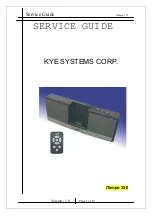
The key to placing your subwoofer for optimal enjoyment
is to remember that low frequencies produce sounds with
long wavelengths, which interact in complex ways with
room boundaries, such a walls and corners, and other
large objects as well.
Placing the subwoofer near to a room boundary will tend
to increase its apparent bass output, but may result in
"boomy" or "muddy" sound. Conversely, placing it farther
away from room boundaries will tend to decrease its
apparent bass output, but may result in improved
articulation and clarity.
When possible, place the subwoofer in the same
horizontal plane and along the same wall as the main
speakers.
And since small changes in subwoofer position can have
a significant effect on sound, experimenting with the
effects of different placements in your own listening/view-
ing room is the key to finding the sound you like best.
SW10 Features & Controls
GAIN:
This control allows you to adjust the volume of
the Subwoofer relative to the rest of your system. Many
listeners make the mistake of setting subwoofers too
loud, which can cause excess bloat and loss of detail and
musicality. A properly calibrated subwoofer blends in with
the speakers and does not call attention to itself. To
properly set volume:
• Turn down the volume control on the SW10 to its
lowest position (counter-clockwise).
• Turn on your audio system, including the SW10. Play
some music you are familiar with and set your receiv-
er/preamplifier volume to a comfortable listening level.
• Slowly increase the volume of the SW10, listening for
proper frequency balance. When balanced, you will hear
improved bass extension, but not be aware that it is
coming from the subwoofer.
From this point on, the volume control on your
receiver/preamplifier will control the overall volume of
your system, including the subwoofer.
AUDIO/VIDEO SWITCH:
This control allows you to
optimize the SW10's performance for either music
listening or movie viewing.
When listening to music, most listeners prefer a flat bass
response that realistically reproduces the sound of live
instruments. For this setting, flip the switch to AUDIO.
Thank you for your purchase of the NHT SW10
powered subwoofer.
Like all NHT loudspeakers, the SW10's development has
been guided by the study of human hearing, it’s design
rigorously tested, and its components optimized to
deliver clean, clear musical sound.
Since the quality of your speakers is one of the most
important factors in maximizing the sound you'll get from
your music and home theater system, we're sure that
you'll find your purchase of the SW10 a good investment,
and invite your comments.
If you find your experience with the SW10 as satisfying
as we believe you will, and wish to enjoy its high quality
sound through your entire system, you'll find information
about other sonically matched NHT Super Series loud-
speakers on the back of this manual.
Background
The NHT SW10 Powered Subwoofer System is a
compact, versatile and powerful 150 watt amplified sub-
woofer designed to provide low frequency reinforcement
for high performance audio and home theater systems.
The SW10 features:
• line-level and speaker-level inputs and outputs, for
connection with all types of receivers or other audio
components
• independent gain, phase and low pass filter controls
• audio/video contour control for adjusting system sound
to the source
Please take a few minutes to read through this owner's
manual before setting up your speakers; this information
will help you get the most out of them. Also, please keep
the SW10's packaging to use in case you move or
transport them.
If you have questions at any time during setup or use,
feel free to call your NHT dealer or our Toll-Free
Customer Hotline at 1-800-NHT-9993.
Placement
Note: To prevent the SW10 subwoofer amplifier from
overheating, always be sure to provide adequate space
for proper ventilation. Do not place the subwoofer
directly against the wall or any other surface.






























